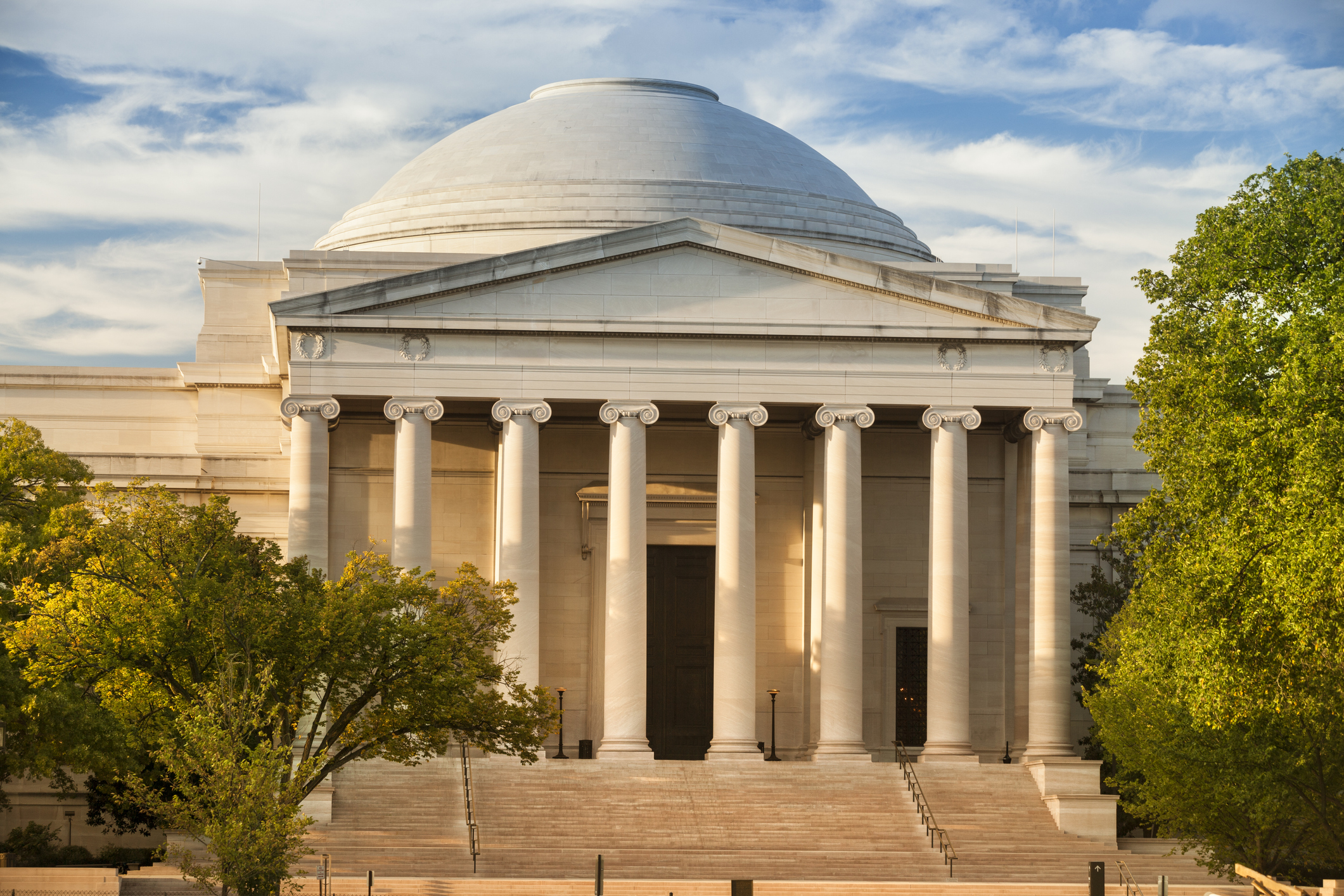The American ideal of self-government is increasingly inapplicable to our culture.
Rebuilding Our Cultural Future

Artists need to band together and revitalize our cratering culture.
You don’t need me to tell you that our institutions have been captured—and that the ones most fully captured pivot around art, culture, and entertainment.
Before humanities departments were crushed under the first steps of the decades-long march of progressives through the institutions, the art world was already yawning at a past revolution. For many decades, leading voices in the cultural sphere had prophesied about nihilism and the destruction of our societal core, telling us that the family, Christian and European influences, and excellence would end. Roger Scruton famously called this phenomenon a “cult of ugliness,” where art began to proclaim the hopelessness and depravity of the worst aspects of human existence rather than point burdened man in the direction of hope and the nobility, beauty, and strength lying latent in his heart. Art went from a powerful tool to lift all to higher things to pressing faces into mud and tormenting bodies with their ugliest, most beast-like passions.
Thus we arrive at pop artists like Lizzo, who rose to fame through being bombastic, shocking, vulgar, nearly naked, and obese, and Billie Eilish for crying tears of dark blood and coughing up spiders—signed-toilet Duchamps for the masses.
That this cult of ideological ugliness has reached its inverted apex is clear. Most of our culture now echoes the Roman theatres where sex, violence, depravity, and mockery took center stage; where bread and circuses—along with raw power struggles—were the people’s sustenance. The main differences now are that our bread is loaded with chemicals and sugar, and our circuses chase us on our handheld idols.
Aleksandr Solzhenitsyn rightly said that in reducing man to pure utility and replaceable market value, the materialism of the West was of the same core substance as communism and would ultimately destroy us. We failed to respond to the spiritual and human needs of our culture through art, but from Woodstock on, we have seen how culture affects not only our artistic experiences but even our most pragmatic interests in family, economy, and safety.
But art can again rebuild much of what has been lost.
Rising Action
The solution is an almost stupid, bold hope and a committed focus on creating great art. People respond viscerally and eagerly to what is beautiful, witty, excellent. We should seize this opportunity.
Ugliness and ideology are difficult to argue against effectively, as these are both deeply embedded and largely sub-rational phenomena. But they can and must be eclipsed.
From my vantage point in the trenches with artists, such an eclipse is possible, even inevitable, if we determine together to see it come to pass. The good news is that we do not lack talent.
Some of the greatest artists on the planet have escaped the crab bucket mentality of leftist ideology and are now wandering alone on dry sand. Squinting, they are starting to find each other.
We have witty sitcom writers and comedians; top musicians, singers, producers, and sound engineers; screenwriters and budding directors. We have poets, novelists, essayists, and editors and the publications and even private competitions giving them a home. We have talented architects, artisans, and painters. We also have a burgeoning classical revival, especially in sacred music, with fresh composers and conductors.
Increasingly, more successful artists are rejecting the ideological arts paradigm, and even more will jump into other options as they become available.
There is also a growing hunger for good quality art among the public, who want aesthetics that captivate the heart and soul as much as the senses. People are flocking to online accounts that post nothing but classical architecture and beautiful art—clear evidence that they are starving for nourishing, challenging, and beautiful visuals, sounds, and words.
A better culture is possible and at our fingertips. We just have to decide that it really matters.
Turning Point
How will this cultural renaissance blossom?
More than likely, it will be slowly, then suddenly. As high-quality work is completed, shared, and starts to gather traction, it will continue to enable more artists and art-adjacent people to work where we most need them due to increasing opportunities.
Although pop culture is sometimes of low interest to people on the Right, these projects will provide a critical starting point. Pop music and film necessarily involve many people and are important, because they promote creative infrastructure between many kinds of artists. They can then connect, collaborate, and spark not only new artistic works but ways of reaching more people. Theater and large-scale classical works also offer similar possibilities.
There is no way forward without artists making the best quality work possible. There can be no compromise and no such thing as lowering standards in order to check the right ideological or religious boxes. Religious and political themes are welcome and needed where authentic, but these can’t become a smokescreen for bad art. Our work needs to be better than the current popular and academic standard, not worse—a tall order, but necessary.
We need to lead the way. We need to go beyond niche, safe Christian or conservative audiences and create compelling pieces that can’t be dismissed or ignored. Put more positively, we need to create art that any honest person can enjoy simply because it is undeniably good.
We will also make serious inroads by being courageous. This is not a time for faint hearts.
We will thrive if we are unashamed of our Western civilizational roots, moral convictions, and the powerful poetry of darkness, light, suffering, joy, and death—life in its full tragedy and richness. While rejecting all kitsch, we should also be unashamed of truly wholesome, simple, charming things, rejecting the premise that these are “unsophisticated.”
We should not only revive, preserve, and excel in the classical and fine arts but venture into pop culture, perhaps bringing along with us the insight and linguistic prowess of classic literature, the beauty of orchestral writing, and the intelligent, piercing use of light and color seen in the great painters—even intentionally referencing these works to bring them back into our mass cultural conversation. A timeless neo-traditional approach, applied to all art forms, will thrive.
We will succeed through openness to quality, even if it isn’t exactly to our personal tastes, with a view to the common good and a strategic understanding of how to reach people, especially the young.
Where lower budgets are a limiting factor, which is likely to be the case for a while yet, we will stand out by ensuring that the inner bones of story, intelligence, wit, and uniqueness and beauty are even stronger. I believe we are up to this task, particularly with a supportive audience who understands the importance of the work. We will succeed by developing an eye for hidden quality and encouraging these to best completion.
Success will also come about by generous funding. We will need small and big patrons and common sense people willing to make funding real art a priority in their lives. We will need investors, especially those who are willing to take chances and view their investment not only as monetary but also as a cultural and spiritual legacy.
Finally, we will succeed by creating our own channels for sharing artistic work in all media. We will no longer rely on the current systems in place but work collaboratively to rebuild our entire industry.
If we do this with good humor, hard work, and a happy warrior philosophy, we will see incredible things come to pass.
Falling Action
There are some pitfalls to avoid in our fight for a cultural revival.
Lack of funding is a perpetual block, and this isn’t a pity trip. Art has always been an endeavor fraught with difficulty, but many of the best artists today have walked away from successful careers for the sake of integrity. They are people of principle who have made enormous sacrifices to maintain the purity of their vocational call and fight against what is evil and unjust in the arts world. What many more people have been experiencing in recent years with woke ideology reaching their HR departments has been the standard in art circles for decades. It is critical that our artists be honored for the critical role they play, not spurned or ignored.
We need generosity toward artists to grow, but we also need to encourage artists to learn, without compromising artistically, to think more practically and entrepreneurially. Most artists aren’t suited for this, but we are working to fill in some of the gap and “translate” between the two camps—pragmatic and artistic.
There’s no pat answer to the problem of funding, but if this problem persists, the culture will not change. Patrons need to engage thoughtfully with the work of living artists, and those with financial ability should seriously consider their role in this mutual project of cultural rebuilding.
Another pitfall to avoid is the elitist trap that in part got us into the current mess: creating things only for our most niche, sophisticated peers rather than for the people. While we absolutely need excellence, nuance, and challenge, this is not the same as veering into something that only serves the egos of creators.
We can’t despise the “masses” we set out to reach or we have already lost. If we do this, we are not only no better than our current elite who hate us but are also rendering ourselves ineffective at transforming the culture.
American poet Dana Gioia writes and speaks about how once art becomes exclusively for the critics, it has abandoned its core purpose. It becomes sequestered in the ivory tower of academia and the “ones who know,” neither receiving nor giving life.
In a similar vein, we need also to resist the reactionary impulse to traffic exclusively in the dark and ironic as a response to the dumbing down of the general culture.
There is a need for this genre across various media, but we also need to affirm goodness wherever we see it and avoid conflating it with bad kitsch. Ridding ourselves of the need to prove our sophistication will set us free to create. It’s worth remembering that A.A. Milne is known almost exclusively for Winnie-the-Pooh, an innocent—if perceptive—work of love for his child, rather than his more serious work. Lightness and ingenuity can be captivating, sometimes for generations to come.
We should also embrace our role in pop culture rather than retreating only to the fine arts. Being open to all strains of culture, from the sublime to the modern to the simple, we will also lift the overall common denominator of our culture, making for richer soil for the most gifted artists among us to grow. This openness also has the added benefit of keeping us attuned to reality and the needs of the people, which helps our work to be driven by a love for those we want to reach, whether it’s biting like Flannery O’Connor or simple and charming like Milne.
Finally, we cannot fall into small-heartedness. We need to be magnanimous. Our situation is serious. Artists and their collaborators need to see each other generously as confreres rather than competitors. Never before has the phrase “a rising tide lifts all boats” been more relevant.
We cannot afford a scarcity mentality or let bitterness and envy take root. There is more than enough work to be done in our desperate cultural landscape, and encouraging each other and lifting up the good work of others will only benefit us all. The more that people and investors see our new emerging sector of arts and culture thriving, the more we will see the snowball effect of growth. With both personal excellence and this disposition of mutual support, there will be a serious new economy for art and artists.
From this, we will also begin to see communities of artists arise, which is the hidden heartbeat of all artistic success. This sense of community is in large part why the ideological Left has been so “successful” in providing at least the mimicry of professional camaraderie so craved by artists.
One of the greatest pitfalls before us is the isolation of the great artistic warriors of our time. But if we seek out, attract, and nurture them, we will in turn be nourished.
Denouement
The world is starving for what our artists have to give. Many people have no hope and little sense of their value beyond experiences of fleeting pleasure.
We are ripe for something better. The evidence of so many cultural, political, and spiritual weeds around us indicates a prepped soil eager to produce. We can be that response.
The talent is truly world-class. Many of us are like racehorses long penned up. Like many, I have been longing to burst forth since self-cancelling out of the music industry years ago. If we can be released and empowered, our intensity will be beautiful and thrilling to watch. We will continue with or without notable cultural success, but we can do so much more with the participation and partnership of those who understand what we are fighting for.
Rebuilding the arts and entertainment world will require much patience, courage, focus, and generosity with each other. But if we don’t build it with and from love, we will just be building ourselves a hollow facade that will easily collapse, if we can even build at all.
We can become a real force against the current cultural tide—maybe much faster than we dream. While political battles fall ever deeper into the moral abyss, culture is truly an open path of hope. If we will intentionally use it for the higher ideals of goodness for our minds, bodies, souls, and families, I believe we will be on the brink of a new era of arts and culture in America and beyond.
The American Mind presents a range of perspectives. Views are writers’ own and do not necessarily represent those of The Claremont Institute.
The American Mind is a publication of the Claremont Institute, a non-profit 501(c)(3) organization, dedicated to restoring the principles of the American Founding to their rightful, preeminent authority in our national life. Interested in supporting our work? Gifts to the Claremont Institute are tax-deductible.
Agnieszka Pilat’s artistic plea for using tech responsibly.
The advertising industry is the unacknowledged legislator of wokeness.
A vengeful quest for social purity ends only in public ugliness.
But humility, courage, and loyalty might.
We are rapidly becoming post-civilized.






